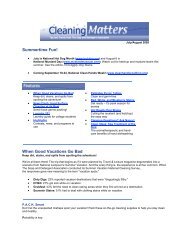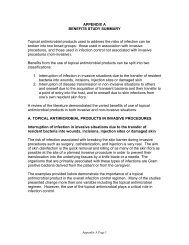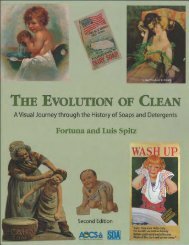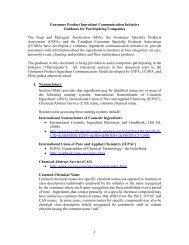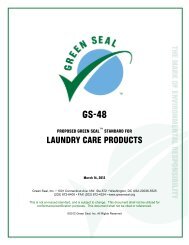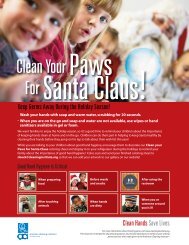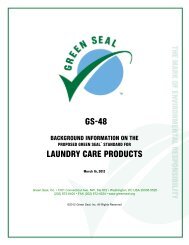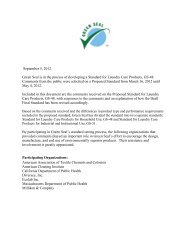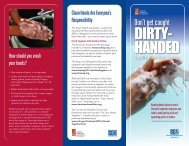subchapter c -- federal hazardous substances act regulations
subchapter c -- federal hazardous substances act regulations
subchapter c -- federal hazardous substances act regulations
You also want an ePaper? Increase the reach of your titles
YUMPU automatically turns print PDFs into web optimized ePapers that Google loves.
16 CFR Ch. II (1–1–05 Edition) – proposed modification – 6/25/06<br />
(3) if the health hazard pictogram appears<br />
for respiratory sensitisation, the exclamation<br />
mark should not appear where it is used for<br />
skin sensitisation or for skin or eye irritation.<br />
(d) Precedence for allocation of signal<br />
words. If the signal word “Danger” applies,<br />
the signal word “Warning” should not appear.<br />
§ 1500.128 Label comment.<br />
The Commission will offer informal comment<br />
on any proposed label and accompanying<br />
literature involving a <strong>hazardous</strong> substance if<br />
furnished with:<br />
(a) Complete labeling or proposed<br />
labeling, which may be in draft form.<br />
(b) Complete quantitative formula.<br />
(c) Adequate clinical pharmacological,<br />
toxicological, physical, and chemical data<br />
applicable to the possible hazard of the<br />
substance.<br />
(d) Any other information available that<br />
would facilitate preparation of a suitable label,<br />
such as complaints of injuries resulting from<br />
the product’s use or other evidence that would<br />
furnish human-experience data.<br />
§ 1500.129 Substances named in the Federal<br />
Caustic Poison Act.<br />
The Commission finds that for those<br />
<strong>substances</strong> covered by the Federal Caustic<br />
Poison Act (44 Stat. 1406), the requirements<br />
of section 2(p)(1) of the Federal Hazardous<br />
Substances Act (repeated in §<br />
1500.3(b)(14)(i)) are not adequate for the<br />
protection of the public health. Labeling for<br />
those <strong>substances</strong>, in the concentrations listed<br />
in the Federal Caustic Poison Act, were<br />
required to bear the signal word “poison.” The<br />
Commission concludes that the lack of the<br />
designation “poison” would indicate to the<br />
consumer a lesser hazard and that such would<br />
not be in the interest of the public health.<br />
Under the authority granted in section 3(b) of<br />
the <strong>act</strong>, the Commission therefore finds that<br />
for the following <strong>substances</strong>, and at the<br />
following concentrations, the word “poison” is<br />
necessary in addition to any signal word:<br />
(a) Hydrochloric acid and any preparation<br />
containing free or chemically unneutralized<br />
hydrochloric acid (HCl) in a concentration of<br />
10 percent or more.<br />
(b) Sulfuric acid and any preparation<br />
containing free or chemically unneutralized<br />
sulfuric acid (H 2 SO 4 ) in a concentration of 10<br />
percent or more.<br />
(c) Nitric acid or any preparation<br />
containing free or chemically unneutralized<br />
nitric acid (HNO 3 ) in a concentration of 5<br />
percent or more.<br />
(d) Carbolic acid (C 6 H 5 OH), also known<br />
as phenol, and any preparation containing<br />
carbolic acid in a concentration of 5 percent or<br />
more.<br />
(e) Oxalic acid and any preparation<br />
containing free or chemically unneutralized<br />
oxalic acid (H 2 C 2 O 4 ) in a concentration of 10<br />
percent or more.<br />
(f) Any salt of oxalic acid and any<br />
preparation containing any such salt in a<br />
concentration of 10 percent or more.<br />
(g) Acetic acid or any preparation<br />
containing free or chemically unneutralized<br />
acetic acid (HC 2 H 2 O 2 ) in a concentration of<br />
20 percent or more.<br />
(h) Hypochlorous acid, either free or<br />
combined, and any preparation containing the<br />
same in a concentration that will yield 10<br />
percent or more by weight of available<br />
chlorine.<br />
(i) Potassium hydroxide and any<br />
preparation containing free or chemically<br />
unneutralized potassium hydroxide (KOH),<br />
including caustic potash and vienna paste<br />
(vienna caustic), in a concentration of 10<br />
percent or more.<br />
(j) Sodium hydroxide and any preparation<br />
containing free or chemically unneutralized<br />
sodium hydroxide (NaOH), including caustic<br />
soda and lye in a concentration of 10 percent<br />
or more.<br />
(k) Silver nitrate, sometimes known as<br />
lunar caustic, and any preparation containing<br />
silver nitrate (AgNO 3 ) in a concentration of 5<br />
percent or more.<br />
(l) Ammonia water and any preparation<br />
containing free or chemically uncombined<br />
ammonia (NH 3 ), including ammonium<br />
hydroxide and “hartshorn,” in a concentration<br />
of 5 percent or more.<br />
§ 1500.130 Self-pressurized containers:<br />
labeling.<br />
(a) Self-pressurized containers that fail to<br />
bear a warning statement adequate for the<br />
protection of the public health and safety may<br />
be misbranded under the <strong>act</strong>, except as<br />
Deleted: instead of<br />
-- 86 --



